The Foundation of Geemu: A Brief History of Early Japanese video games
by Martin PicardAbstract
The paper offers a short history of the origins and the establishment of the Japanese video game industry (from 1973 to 1983). It argues that specific local developments of a video game industry and market took place in Japan, which has never been addressed in Western histories of games, mainly interested in Japanese video games through a global perspective. This historical investigation shows first that the Japanese video game industry developed from a specific socioeconomic context, which resulted from Japan's economic growth after the World War II and international trade relations that were established primarily with the United States. It was through the already established Japanese electronics and toy corporations that the arcade, home console, and personal computer markets were established. Then, the examination focus on the implementation of these three sectors in the Japanese video game industry, which have, each in their own way, deeply affected the evolution of video games, not only in Japan, but also in international markets. After an historical overview of each of these sectors, the author concludes with some key consequences of the contribution of the Japanese video game industry on the industry as a whole.
Keywords: Japan, history, industry, arcade, home console, PC, Geemu
A common discourse about Japanese video games and the contribution of Japan to the video game industry as a whole is to tie them to the development of a global and hybrid industry. Indeed, the globalization of the video game industry, encouraged by the incursion of Japanese corporations in North America and Europe, is undeniable (Consalvo, 2009; Kline, Dyer-Witheford, & de Peuter, 2003). Their products circulate across transcultural and global flows, and video games’ contents are now better understood as complex flux as opposed to national or even cultural manifestations (Consalvo, 2006). This aforementioned discourse nevertheless underlies an assumption firmly rooted in video game studies and historical accounts of video games: it is as if the only manifestation of the Japanese video game industry had been made on a global level, while the specific development of the industry on the Japanese territory had never existed.
Unfortunately, these assumptions tend to neglect the complex geopolitical and socioeconomic negotiations taking place on Japanese territory -- before, during, and even after the creation of a global media complex -- forming tangible distinctions between the Japanese and the North American (or European) market as each tries to divert and capture these flows. Despite alliances, collaborations and interdependencies that were played globally, many crucial events that were set on Japanese territory must be taken into consideration. The Japanese video game industry is both a global and local phenomenon, and the two aspects must be distinguished in order to avoid misinterpretations and omissions in histories of video games.
To better understand the complex development of the industry, we must reintroduce local considerations into global perspectives by examining the economic and cultural development of the video game industry in Japan in order to nuance and add new insights about global and transnational discourses. General knowledge about Japanese video games, coming usually both from historical books and video game studies in the West, as well as through the discourse of the specialized press and media, and online fan communities, is only one facet of the world of video games in Japan[1].
Since, as Kline et al. rightly asserted, the development of “digital play” was conducted jointly through a complex process in the three circuits of technology, culture, and marketing (Kline et al., 2003), we must acknowledge that the Japanese video game industry has its own process through these circuits, including of course its global and transnational aspect, but which constitutes only a part of the overall picture.
The Geemu system
Similar to the work of Marc Steinberg on the anime’s media mix (Steinberg, 2012), we must examine the economic and material conditions of the video game industry in Japanese territory to better understand the evolution of video games globally, locally and everything in between. In this sense, the emergence of the video game industry in Japan is a “development that is informed by a unique set of historical and material circumstances” (Steinberg, 2012, p. xiii) that cannot be reduced uniquely to a model of globalization.
The Japanese video game industry is at the intersection of local innovations in marketing strategies -- in part in a context commonly called themedia mix, which is itself linked to a broader context of a consumption culture that has risen up from contemporary, and some would say postmodern (Azuma, 2007, 2009), Japan -- national industrial transformations -- whereas the Japanese video game industry is at the crossing of electronics, computer, amusement and content industries in Japan -- and technological and artistic developments -- from the hardware to the software -- in which some aspects were, subsequently or synchronously, established globally and under an increasingly transnational mode, all forming a particular media ecology or system, that I name “geemu”[2].
In this article, I will highlight some significant historical features[3] related to the emergence of video games in Japan to show that there is indeed a local market that has been shaped from the outset in a specific context, which led to the emergence ofgeemu. It is therefore necessary to explain this origin in order to understand not only Japanese video games per se, but also why and how they went global.
Geemu in context
In the first fifteen years of the development of the video game industry in Japan (from 1973 to the late 1980s), we can witness the formation and the emergence of main features of geemu. Japanese video games, or geemu[4], are not linked to an ‘essence’ of any kinds (national, mediatic, etc.), but to a market, or rather to -- admittedly unstable and fluctuating -- markets[5]. Consequently, this economic structure has led to a specific Japanese gaming culture, or rather cultures (and subcultures)[6], which are themselves mobile and shifting under the influence and regulation of industrial infrastructures (console manufacturers, publishers, developers, marketers, localizers, etc.), and interpretative communities (specialized press and media, gaming and fan communities, etc.). Thus, geemu is both global (with its transnational arrangements), local (since it is a market partially isolated), and “glocal” (sometimes playing on the two fronts at once, and including both the “globalocal” and “localization” concepts) phenomenon, as well as a concept influenced by various discourses (from the industry, the fans, the academia)[7] and practices which evolve according to social, cultural, economic and (trans)national contexts.
Like Aoyama and Izushi already attested, the evolution of the Japanese video game market is linked to a specific economic and cultural context:
We argue that the cross-sectoral transfer of skills occurs differently depending on national contexts, such as the social legitimacy and strength of preexisting industries, the socioeconomic status of entrepreneurs or pioneer firms in an emerging industry, and the sociocultural cohesiveness between the preexisting and emerging industries. Each country draws on a different set of creative resources, which results in a unique trajectory. […] Japan's video-game industry emerged out of corporate sponsorships in arcades, toys and consumer electronics industries and drew skills from the comic book and animated-film sectors… (Aoyama & Izushi, 2006, p. 1843).
In the context of this article, I will briefly focus on the implementation of three sectors in the Japanese video game industry: the arcade, the home console and the personal computer, which have, each in their own way, deeply affected the evolution of video games, not only in Japan, but also in international markets. After an historical overview of each of these sectors, I will conclude with some major consequences of the contribution of the Japanese video game industry on the global level.
The socioeconomic context of post-war Japan: the settings for the establishment of a video game industry
If, as stated by Kline et al., “[t]he invention of the video game could not have taken place without … foundational developments in the computer industry and at university research institutes -- all subsidized by the military-space complex” (Kline et al., 2003, p. 86), the emergence of a video game industry in Japan has developed in a different context. The Japanese video game industry is one of those industries in Japan that was imported from the United States during the twentieth century, but that was able to somehow “improve” the model. The formation of the Japanese video game industry is strongly tied to the specific socioeconomic situation of Japan after World War II. Some major industrial sectors took part in the birth of the game industry, from amusement and consumer electronics industries to toy and television manufacturers. The Japanese video game industry was not supported by the military-academic complex[8], or even initiated by start-ups, but rather developed from the outset by entertainment corporations and import/export businesses that were already well established in the consumptive post-war Japan.
The economic development of Japan after the war, which has led to the arrival and the success of the Japanese video game industry, is large and complex. However, we can highlight some foundational events, as some key industries were developed that have had, at one time or another, significant influences on the arrival and the development of the video game industry, such as the successful household electrical appliances industry (Yoshimi, 1999) and the computer industry (Nakayama & Yoshioka, 2006). We can add to this the sociocultural consequences of the introduction of television and home entertainment, the leisure boom (rejâ bûmu) (Linhart, 2009), and the outbreak of mass consumption, tied to aggressive government campaigns for the consumption of ‘Made in Japan’ products, which have allowed technology to grow rapidly (Yoshimi, 1999). All these factors contributed to build a solid infrastructure to ensure the success of an industry such as the video game.
Thanks to the successful Japanese economic structure already in place during the 1970s, a video game industry could be developed in Japan, while playing very hastily an influential role on North American and European territories. Japanese corporations, through their business experience in neighbouring industries, import/export business and joint ventures with American companies, invested in the emerging market, to the point where they became in the space of a decade (from mid-1970s to around mid-1980s) the undisputed leaders -- both in hardware and software developments -- in the global industry, at least until the late 1990s.
The emergence and early developments of the Japanese video game industry have been made through intertwining and overlapping sectors, which include nonetheless different business strategies and different sub-sectors. In order to make a better sense of the overall picture, I will now divide these developments into three segments. First, within the already well-established market of overseas collaborations in the fields of electronics, toys and public and home entertainment, import and clones of the first arcade and home consoles from North America were quickly followed by the export of the first video games from Japan. Then, the early collaborations of Japanese companies with pioneer American video game ones, as well as the investment of television manufacturers in home entertainment and consumer electronics corporations in the nascent home computer industry, helped the emergence of the ‘Made in Japan’ home console and personal computer markets. Finally, thanks to Nintendo, the “Famicom boom” greatly transformed the landscape of home entertainment in Japan, and then in North America, Europe and other parts of the world as the Nintendo Entertainment System (NES). These events established the foundations of the video game industry, not only in Japan, but globally -- foundations that are still largely present today.
The amusement machine business and the first arcade video games: the beginning of the video game industry in Japan (1973-1983)
As we have explained, the birth of the video game industry in Japan is directly linked to the economic and cultural contexts that were established in the twentieth century. For example, in the case of the electrical and electronics industry, structural changes during the period of high economic growth and especially the shift to overseas production were essential to stimulate Japanese corporation’s investment in the rising electronic game industry (Kohama, 2007). In fact, four already established Japanese entertainment companies have contributed to the importation and development of video games in Japan: Sega, Taito, Namco and Nintendo.
In Japan, the advent of the arcade game could not have happened without the prior development of the amusement business. Roots go as far as the Corinthian games introduced during the Taisho Era (1912-1926) at Japanese festivals, exhibitions and other outdoor entertainment venues, and later with department store rooftops and pachinko parlors (Eickhorst, 2006, pp. 14--17). Nearly a year after the commercialization of one of the first video game in the United States (Atari’s Pong in 1972), Japanese amusement machines companies became quickly involved in the burgeoning industry. Two companies in particular, Taito and Sega, created Pong clones to distribute them in amusement spaces as early as July 1973[9].
Thanks to their overseas relationships, Japanese companies already knew very well what was happening on the US market and were fast to react accordingly.
Taito, founded in 1953 by a Russian businessman and which specialized at the time in importing vending machines, released Elepong in July 1973. The
same month, Sega, a merging of Rosen Enterprises and Service Games -- founded by two Americans, but settled in Japan after the World War II to import US
amusement machines especially for American military bases established in Japan (Eickhorst, 2006, pp. 18--21) -- also released a Pong clone,Pong Tron, followed a few months later by Pong Tron II and Hockey TV. Also in November 1973, Taito released other clones such asSoccer and Pro Hockey.
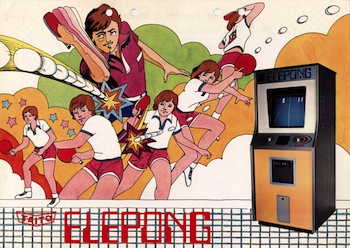
Figure 1. Flyers of Taito’s Elepong and Sega’s Pong Tron, both released in July 1973.
As soon as 1974, Japanese companies began exporting their products, such as Taito’s Speed Race (November 1974) and Western Gun (September 1975), distributed by Midway in the United States. The latter was renamed Gun Fight and advertised with reworked flyers (Kohler, 2004, pp. 18--19), being in that manner an early example of localization. Meanwhile, Namco, founded in 1955 as Nakamura Manufacturing Corporation, formed a partnership with Atari to become the official distributor of Atari games in Japanese territory. In November 1973, Nakamura Amusement Machine Manufacturing Company distributed the original Atari’s Pong, and then a dozen other Atari arcade games before creating their first games in the late 1970s now under the acronym Namco[10]. Nintendo, founded in 1889 and makers of hanafuda card games, which also joined the toy industry (thanks to engineer Gunpei Yokoi’s inventions) (Makino, 2010), also took part, at the end of the 1970s, to the outbreak of arcade gaming in Japan (Gorges, 2012).
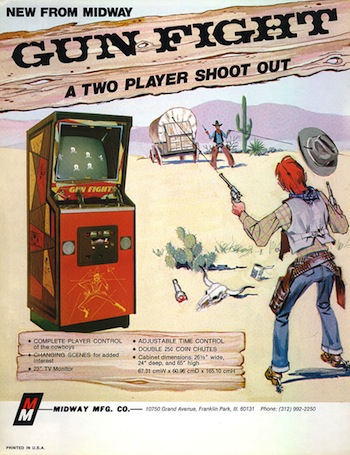
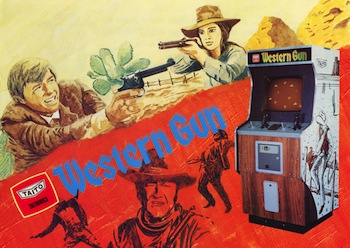
Figure 2. Flyers of Taito’s Western Gun and Midway’s Gun Fight.
Therefore, the Japanese video game industry began not only in a context of importation, but also of strong competition and through a model of “cloning”, whereas strong commercial successes were quickly followed by similar products[11]. Until the end of 1978, these companies developed or distributed over a hundred arcade games, some of which were exported to the United States, but all of which with a modest success in Japan, until the arrival of Space Invaders by Taito in July 1978, marking a turning point in the video game industry in Japan, as well as in North America (Akagi, 2005, pp. 147--164).
Gaming invites itself at home: the emergence of the home console and the computer game markets (1975-1983)
If the birth of the video game industry in Japan was made in the arcade sector, mainly by amusement machines companies; consumer electronics, toys and television manufacturers companies participated in developing a home video game market. And, as it is the case in the arcades, it all started through overseas business collaborations. For example, in 1971, Nintendo had -- even before the marketing of the first home console in the United States -- an alliance with the American pioneer Magnavox to develop and produce optoelectronic guns for the Odyssey (released in 1972), since it was similar to what Nintendo was able to offer in the Japanese toy market in 1970s (Gorges, 2012). Thus, Nintendo was directly involved at the onset in the home video game industry, and through these partnerships, the company was able to have a direct look at the industry in North America (Gorges, 2011).
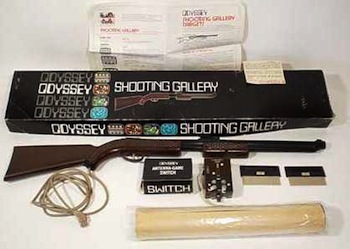
Figure 3. The Magnavox Odyssey’s Shooting Gallery.
However, the production of ‘Made in Japan’ home consoles started in 12 September 1975 with the toy company Epoch[12] and its “TV Tennis Electrotennis”. Epoch made a partnership with Magnavox for the development of the technology, as this console was wireless and functioning through a UHF antenna. It was obviously a Pong clone for the home, and was probably released even before the Atari “Home Pong” which has supposedly been commercialized by Sears for Christmas 1975 (Kent, 2001, p. 242). From 1975 to 1983, until the arrival of the Nintendo Family Computer (Famicom) in 1983, around 125 home consoles were released in Japan, most of them Pong clones and dedicated consoles, including importations of US consoles Odyssey (1974) and Atari VCS (1977) (Atsugi & Mizusaki, 2000; Game Museum, 2005, pp. 5--9).
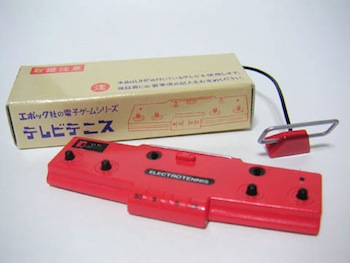
Figure 4. Epoch TV Tennis/Electrotennis, released in September 1975.
During the mid-1970s, 90 percent of Japanese consoles were made by television giants (Toshiba, Sharp, Matsushita/Panasonic); hence the adoption of the name “TV geemu” (or terebi geemu) as the main designation for “video game” in Japan and which will remain throughout the years. Among all these “TV Game” consoles, Nintendo were the most successful with their first machines, the “Color TV Game 6” and “Color TV Game 15”. The success was unexpected for Nintendo, especially since the company did not want to invest in the home console market to begin with. According to Gorges (2011, pp. 14--15), Nintendo’s president Hiroshi Yamauchi was not convinced of the potential of the domestic machines during the 1970s. He did not believe that the primitive graphics of the first console games would appeal to the Japanese public. He preferred at the time the greater “realism” of arcade games (Gorges, 2011, p. 13). However, as the electronics giant Mitsubishi Electronics lost its partner Systech, then bankrupt, they approached Nintendo to form a partnership. Yamauchi accepted because the risk was minimal. Mitsubishi had an undeniable technological power and production force (Gorges, 2011, p. 14). Thanks to a strongly competitive price point (9.800 and 15.000 yen respectively, as the competitors were rarely under 20.000 yen), they sold one million units of the two machines combined (about 350 000 and 700 000 respectively) (Game Museum, 2005, p. 8).
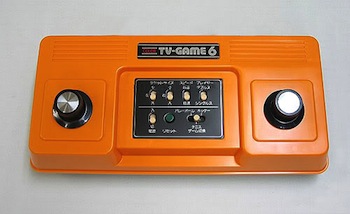
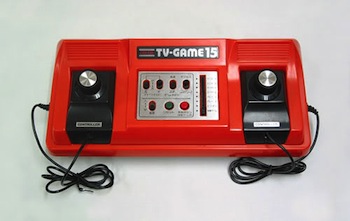
Figure 5. Nintendo’s Color TV Game 6 and Color TV Game 15, released in 1977.
The home computer industry
The foundation of a major electronic entertainment industry, as well as the export of Japanese video games in the US territory, was not done uniquely in home console and arcade sectors, but also in the home computer market. Shortly after the first successful micro-computers and personal computers in the West (the Apple II, the Commodore PET and the TRS-80 in 1977), Japanese electronics companies, such as Canon, Hitachi, Matsushita, Mitsubishi and Sony, were also keen to start their own market on their territory, especially since a good portion of the parts used in personal computers at the time were manufactured in Japan. Following the United States, they developed an R & D program powerful enough to be self-sufficient on their territory[13]. They developed several computers designed solely for the Japanese market, causing a mai-con (micro-computer) boom at the end of the 1970s with models such as the Sord M200 Smart Home Computer series announced in September 1977 and the more successful semi-kit Sharp MZ-80K put on the market in December 1978.
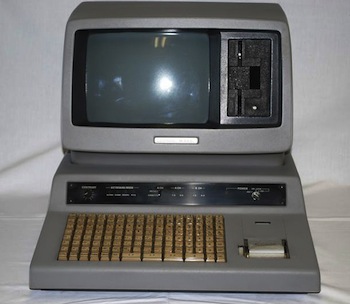
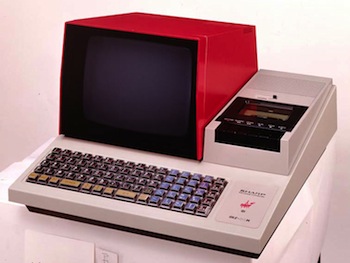
Figure 6. The Sord M200 Smart Home Computer and the Sharp MZ-80K.
Since Japan was already booming in the development of arcade video games at the turn of the 1980s, and as home computers elsewhere were becoming especially dedicated to playing video games (since their graphics and sound were more advanced than business computers), video games also became in Japan the main software associated with personal computers (pasokon) such as the NEC’s PC-8001 (1979), PC-8801 (1981) and PC-9801 (1982)[14], the Sharp X1 (1982) and X68000 (1987), the Fujitsu FM-7 (1982) and FM-Towns (1989), the Tomy Pyuta (1982) and the Toshiba MSX (HX-10) (1983).
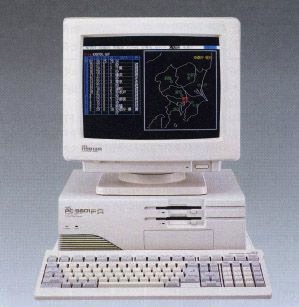

Figure 7. The NEC PC-9801 and the Toshiba MSX HX-10.
The success of the PC-8001, PC-8801, PC-9801 and the MSX standard brought many Japanese video game developers to produce exclusive titles for these platforms. Series such as Dragon Slayer (PC-8801; Nihon Falcom, 1984), Thexder (PC-8001; Game Arts, 1985), Ys (PC-8801, Nihon Falcom, 1987), Metal Gear (MSX2, Konami, 1987), Snatcher (PC-8801,Konami, 1988) and RPG Tsukūru (PC-8801, 1988, RPG Maker) made their debut on these platforms. Companies such as ASCII (founded in 1977), HAL Laboratory (1980), Nihon Falcom (1981), Micro Cabin (1982), Enix (1982) and Square (1983) all began their video game production in the personal computer software industry. The PC-9801 remained popular until the end of the 1990s with thousands of games developed for it, as it stayed until Windows’ takeover the platform of choice for indie game development (doujin soft) and niche genres, such as dating sims and RPGs.
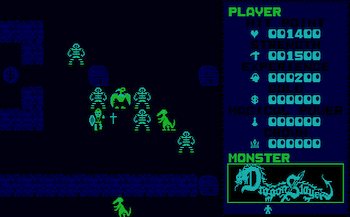
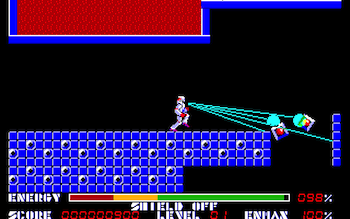
Figure 8. Screenshots of Nihon Falcom’s Dragon Slayer and Game Arts’ Thexder on the NEC PC-88.
Eventually, the success of the Famicom and its dominance in the mid-1980s shifted the video game development industry from home computers to home consoles (at least in the case of major video game developers). However, as in the United States and the United Kingdom with the strong devotion of then PC hobbyists and now independent developers, the PC market led to the emergence of doujin soft (or doujin geemu) in the early 1980s. Initially, they were distributed by mail order on cassette tapes or floppy disks, or even "on line" via a telephone modem. In the mid-1980s, doujin soft began to be distributed at conventions and marketplaces, such as the Comic Market (Lam, 2010). Formation of “circles” dedicated to creating and sellingdoujin geemu helped to popularize genres such as ren’ai geemu (love or dating sims), galge (girl games) and visual novels. Some titles have been having strong followings in fan cultures, such as Touhou Project (NEC PC-9801, 1995-1998; Windows, 2002-present) by Team Shanghai Alice,Tsukihime (Windows, 2000) and Fate/stay night (Windows, 2004-present) by Type-Moon orHigurashi no naku koro ni/Higurashi When They Cry (Windows, 2002-2006) by 7th Expansion.
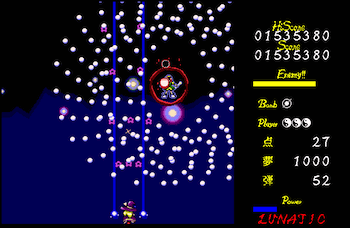

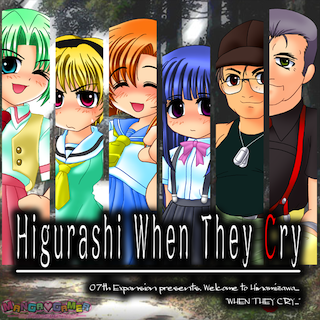
Figure 9. Screenshot of a Touhou Project game on the NEC PC-98 and covers of Type-Moon’s Tsukuhime and 7th Expansion’s Higurashi When They Cry (localized by MangaGamer in 2009).
The arcade game triumph and the Japanese video game invasion in the West (1978-1983)
Along with the video game gradually implanted in Japanese homes, other major events were played in Japanese public spaces, as well as internationally with the invasion of Japanese arcade games in North America, Europe and elsewhere in the world. In 1978, Taito put on the market one of the most popular arcade game of all time (and by far the most successful in Japan), Space Invaders (released in July 1978), which began the true invasion of Japanese gaming creativity in the global video game industry (Kent, 2001, pp. 310--316). In Japan, the game became a social phenomenon with “Invader House” appearing in every urban centre, as all public establishments wanted to install cocktail-table Space Invaders cabinet in their café or amusement spaces. The success was so massive that it legendarily caused a temporarily 100 yen coin shortage (Akagi, 2005, pp. 157--158).
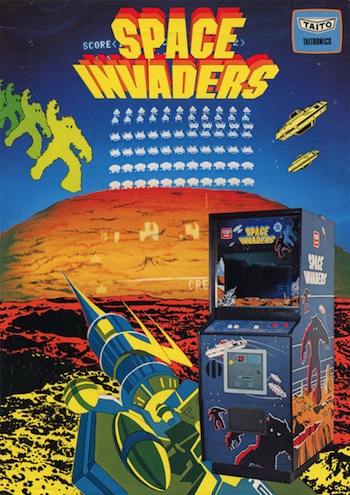
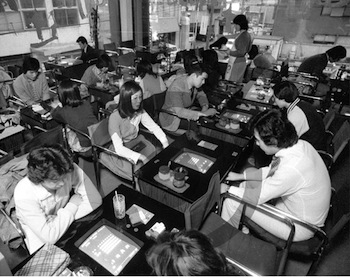
Figure 10. Flyer of Taito’s Space Invaders and a photograph of a typical “Invader House” at the end of the 1970s.
As was the case with any successful arcade games at the time, Space Invaders was the subject of a series of clones (instigating the whole genre of shooting games, commonly named shoot’em ups or shmups in the West, which will remain popular in Japan, as much in arcade games than on home consoles), which Galaxian (October 1979) by Namco was the most important successor. Namco followed a year later with another enormous success, Pac-Man (22 May 1980), whose cultural imprint, both in Japan and -- this time probably even more -- in the West, have also been extensively discussed in historical works (Akagi, 2005, pp. 197--202; Donovan, 2010, pp. 227--236; Kohler, 2004, pp. 21--24).
Nintendo, thanks to the success of its 1977 home consoles, decided to follow the trend and enter the arcade video game market. Before investing in video games, Nintendo was already present in the Japanese entertainment industry with its electromechanical machines or shooting simulations (Gorges, 2012). Their earlier partnerships with home console companies, the damaging oil crisis of 1973, which forced Nintendo to withdraw from the amusement machines business, as well as the phenomenal success of Space Invaders, were all deciding events for the reorientation of the company to enter the arcade video game market (Gorges, 2011, pp. 15--16). Consequently, Nintendo created a subsidiary for its entertainment activities, Nintendo Leisure System, and started to develop clones of existing titles, such as Computer Othello [June 1978], Block Fever [November 1978], a clone of Breakout, and Space Fever [February 1979], a clone of Space Invaders. Towards the end of 1979, they started developing minor original titles such asMonkey Magic [August 1979] and Sheriff [October 1979], until the release of Donkey Kong [August 1981], designed by Shigeru Miyamoto under Gunpei Yokoi’s supervision, which became by far the most successful Nintendo arcade game[15].


Figure 11. Brochure of Nintendo’s first arcade game, Computer Othello, and a flyer of Nintendo’s Color Space Fever.
At the end of the 1970s and early 1980s, several other Japanese companies entered the arcade market with great success, such as Konami, Data East, Irem, SNK, Nichibutsu, Sunsoft, Jaleco, Tecmo and Capcom. Their success will continue as third party developers in the home console market, thanks to the phenomenal success of the Nintendo Family Computer.
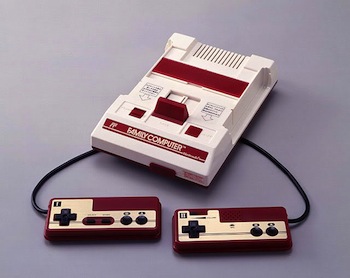
The Famicom boom (1983-1990)
The impact of the Family Computer (Famicom)[16] on the subsequent development of the industry is undeniable. For example, Katayama Osamu compares symbolically the launch of the Famicom with the opening of Tokyo Disneyland as defining moments for the transformation of Japan as a society of leisure:
Its launch coincided with the opening of Tokyo Disneyland, an event many saw as marking a shift in Japanese popular culture from the compulsive work ethic of postwar reconstruction towards a greater interest in entertainment and leisure activities (Katayama, 1996, p. 161).
Several business decisions, but also accidental events (Gorges, 2011), marked the entrance of Nintendo in the video game industry and the home console market up to its huge success in Japan[17], and then in other worldwide territories. The Famicom/NES success is a good example of the confluence of the three circuits of technology, culture and marketing (Kline et al., 2003).
The story and historical importance of the Famicom and its Western counterpart, the Nintendo Entertainment System (NES), have already been extensively discussed (Donovan, 2010; Gorges, 2011; Kent, 2001; Tane, 2008), therefore I will not repeat what has already been said. However, it is important to note that the business strategies developed by Nintendo for the development, the marketing, the launch, and the support of the console had an unquestionable impact on the development of the video game industry thereafter, both in Japan and in North America, Europe and elsewhere. For example, in hardware development, they made, among other decisions, the bet to manufacture a technologically advanced machine at a lower cost to the rest of the competition, as well as to reverse the way to design a machine where the software defined the requirements in terms of hardware rather than the contrary (Gorges, 2011)[18]. In the commercialization of the console, they opted for a “razor and razor-blade” business model, in which no benefit was made on hardware, but on software. They also developed tactics of mobilizing “pester-power” (Kline et al., 2003, pp. 118--121), in which to sell hardware to their target consumers, the kids, they needed to attract adults by offering, as soon as the launch window, more "mature" games (like go and mah-jong games, sports simulations such as golf, soccer, or baseball and a few educational games).
As Kline et al. have mentioned:
Promoting the Nintendo brand as a family-oriented entertainment industry was central to the company’s thinking about product and market development, from the Famicom name to the resources dedicated to Donkey Kong, Mario, and later Zelda (Kline et al., 2003, p. 119).
In order to increase and sustain the commercial success of the console, they also carefully managed an effective structure of production and consumption, from licenses to third party publishers, rigid in-house software development infrastructures, and carefully planned promotional activities that initiated a gaming culture in Japan and around the World, as they “developed in-store ‘World of Nintendo’ merchandising displays; sponsored video game competitions; established cosponsorships and cross-licensing arrangements with [multinationals]; and set up a network of over 250 fan clubs” (Sheff, 1999, p. 175).
The “Famicom culture” was built gradually with the emergence of numerous video game magazines, often focusing particularly on the Famicom, whose pioneers are Beep (1984-1989), the monthly Family Computer Magazine (started in 1985), which will become the bimonthly Famimaga and nowNintendo Dream, and the bimonthly and thereafter weekly Family Tsuushin (1986-1995), which will eventually become Famitsu (1995-present), the most popular magazine today. In addition, the Japanese publishing industry has developed, since 1985, a very lucrative market ofkouryakubon, including the one dedicated to Super Mario Bros. that was the best-selling title of the year 1985 in Japan (Gorges, 2011, p. 100), as well as urawaza, both still very popular today with dedicated sections in bookstores.
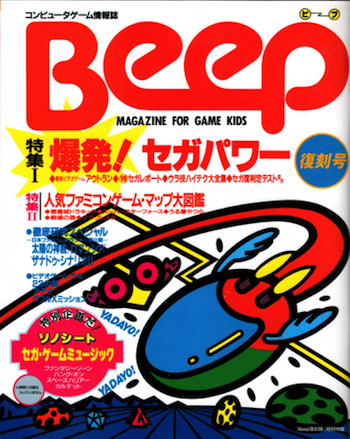
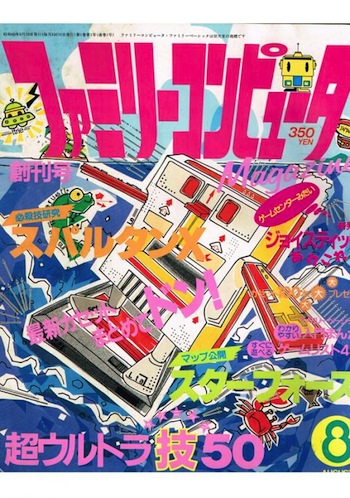
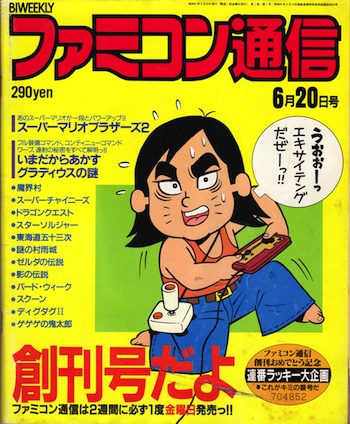
Figure 13. Covers for the first issues of Beep (December 1984; reprint issue), Family Computer Magazine (July 1985) and Family Tsuushin (June 1986).
The “TV geemu generation”[19] was also largely established through the contribution of a single game, which then became a series and a franchise, Super Mario Bros. (September 1985). As explained by Gorges (2011, pp. 60--63), Super Mario Bros. causes a major change in the Japanese industry, whereas before its release, all titles seemed to sell thousands of copies. Yet, after its incredible success (6.81 million units sold in Japan), only certain games and franchises, including Mario obviously, were successful in obtaining a significant profit on the Famicom, such as the Dragon Quest series from Enix, the series of baseball games Family Stadium from Namco, the Zelda series from Nintendo, the Final Fantasy series from Square, plus a few anime and manga licenses[20]. Thus, as explained by Gorges:
[I]n hope to sell cartridges and earn money, from now on publishers needed to produce high quality games or to succeed in entering in one of the following cases: creating ports of popular arcade licenses; quickly getting agreements with famous licenses; or having a significant marketing support to promote widely its titles in media (Gorges, 2011, p. 62).


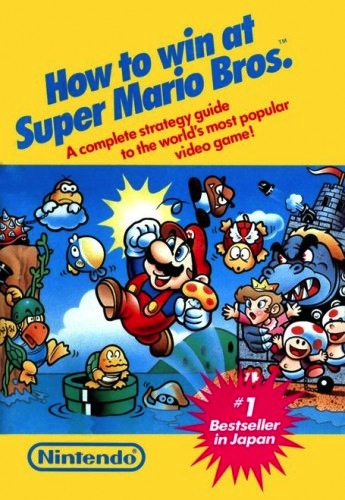
Figure 14. Japanese box art of Super Mario Bros., with its bestseller kouryakubon (strategy guide) and the translated version by Nintendo of America sold via the Fun Club News and early issues of Nintendo Power.
Perhaps even more significantly for gamers, the contribution of Nintendo (and Super Mario Bros.) was to bring a specific “personality” to their games, which has been having a strong influence on the development of video games in Japan as well as globally. As admitted by Kline et al.:
It was through the Mario games that Nintendo put its unique stamp on video game culture. While many earlier and later games -- from Spacewar to Doom -- obviously display their deep affiliation with military-industrial culture, Mario appears to be made of different stuff, a stuff of purer playfulness, wit, and humour (Kline et al., 2003, p. 118).
Coda: the formation of a glocal industry
The origins of geemu in Japan (and particularly the success and dominance of Nintendo) set the stage for the subsequent evolution of the video game industry, such as the institution of corporate culture values through the takeover by Japanese corporations, the development of hardware and software mostly targeted to kids by the Japanese toy, television and entertainment companies, and the promotion of a glocal industry, that is both local and global.
Japanese firms, coming from amusement, electronics and toy industries have implemented business models and marketing strategies[21] that became standards in the industry. These have given rise to a corporate logic that forced the rest of the industry to focus on marketing strategies and technological development of the hardware, while putting in place a solid industrial infrastructure of software development that still has an impact today. In addition, like for most post-war Japanese industries, the Japanese video game industry segmented the market into three main areas, forming a “triad power” (Ohmae, 1985): Japan, the United States and Europe. Moreover, the use of cultural icons and mascots, such as Nintendo’s Mario or Sega’s Sonic the hedgehog, also served companies’ marketing and branding interests, perhaps even more when they introduce their products in the overseas markets, therefore serving as much as “brand nationalism” in marketing “Japan” (Iwabuchi, 2010)[22] than as “transcultural currency” for the global “commodification of play” (Allison, 2006a, 2006b).
The Japanese video game industry was successful because it took place in an already globalized economic context elaborated throughout the second half of the twentieth century by Japanese companies and multinationals. But the success could not have happened overseas without the establishment of a strong local industry. Thus, in the Japanese video game industry, as in any Japanese industry that has expanded in the global market, the local and the global have always been complicatedly entangled with each other. However, unlike many other ‘Made in Japan’ products, the “national” aspect has never played a marketing role overseas[23], as the global and the national were almost always separated, being replaced by the transnational, which probably explains in part why Western commentators have usually been unaware of the domestic side of the Japanese video game industry.
However, as noted by Takashi Inoguchi (2009), not all products are exported and several Japanese video game companies, as with other cultural industries, still prefer to export only products that are already well recognized and that conform to a non-Japanese view of Japanese culture, fearing to export products they judge distinctly "Japanese”. Therefore, we should not overlook the Japanese domestic market, which still plays a crucial role for the global video game industry, especially when companies make decisions in their localization practices[24].
The complex negotiations at work locally in the Japanese video game industry may be understood as a form of "permeable insulation", as conceptualized by Schaede and Grimes (2002), which describes “Japan’s attempt to manage the forces of globalization by affecting both the speed and the reach with which global rules and markets affect domestic players” (Schaede & Grimes, 2002, p. xi). The “insulation” can be seen in “industry-led efforts to ensure survival by informally regulating domestic competition” (Schaede & Grimes, 2002, p. 7). But this insulation is “permeable” in the sense that is not absolute, but rather “allows for differentiated application by industry, institutions, or issue areas” (Schaede & Grimes, 2002, p. 7). Therefore, this concept means “that Japan’s response to the global and domestic challenges of the 1990s is neither one of retreat and denial, nor one of full acceptance of global standards and practices” (Schaede & Grimes, 2002, p. 8).
From cultural protectionism to global pursuits, the Japanese video game industry is rather complex, even sometimes paradoxical, but mostly not one-dimensional. If the industry is indeed hybrid, it is unique at the same time, therefore both global and local, as well as glocal.
Notes
[1] Which includes several specific manifestations, such as the popularity of the Dragon Quest series (Enix) and roleplaying games (RPGs) in general; the Monster Hunter phenomenon (Capcom); the game centers (geemu sentaa or geesen), including many different subgenres of arcade games, from fighting and rhythm games to trading card-based online games and medal video games (Ashcraft, 2009); PC games anddoujin soft including visual novels, dating sims and eroge (erotic or adult video games); otome games (targeted towards a female market); mobile games produced by companies such as DeNA and Gree; the media mix and so forth, to name just the most obvious examples.
[2] "Geemu" is the Japanese term for "game", while more specifically the term "video game" is commonly used in Japanese as "TV geemu" or " bideo geemu". For reasons of simplicity, and because the term is often used in common parlance in this simplified form, I use simply "geemu".
[3] For obvious reasons of space, I will only provide a survey. Many aspects in this article would need further developments and even their own papers, but when even a brief critical history of Japanese video game has never really been addressed in game studies, this overview seems to be the necessary first step to make.
[4] As in “manga” or “anime”, the term “geemu” refers both to the media than products or games. Here, "Japanese video games" or "geemu" can be used interchangeably since they both mean the same.
[5] The formation of multiple markets is mainly due to a strong segmentation in the industry, as it is the case for other major content industries in Japan. However, market segmentation in the video game industry is characterized by generic distinctions (RPGs, fighting games, shoot’em ups, puzzle games, sports and race games, simulations games, dating sims, visual novels and so forth, to name only the most popular to Japanese players) and divided into "sectors" according to different game platforms (arcade, home consoles, portable and mobile consoles, personal computers [PC]) (Tomita, Minamida, & Tsuji, 2007).
[6] These manifest themselves through various cultural practices -- of consumption, fan activities, reappropriations and so forth -- related to contexts such as the media mix and otaku culture, as well as particular gaming cultures, going from reading specialized press about video games (such as Famitsu), kouryakubon (strategy guides) or urawaza (game tips and tricks), to participations at dedicated game websites, blogs or forums (such as 2ch), through retro-gaming shopping at Akihabara or attending 8bit music concerts, as well as students’ gatherings at McDonald’s to play Monster Hunter via network on the Sony PlayStationPortable (PSP), and so on.
[7] Just to give one example. As it is the case for anime and manga, the notion of "Japaneseness" has been rarely questioned in popular discourse, while academic discourses in recent years have tried to emphasize the dangers of any essentialist or orientalist discourse to such an extent that, as stated by David Surman in the case of his aesthetic considerations of Japanese video games through the design and visual aspect ofPokémon, “fears of exoticism and misinterpretation have stalled the formal scrutiny of Japanese videogames” (Surman, 2009, p. 160).
[8] The simple reason is that Japan no longer had an Army after World War II. More specifically, after the defeat against the United States, Japan was forced to change its Constitution and to maintain only a Self-Defense Army. Therefore, the military lost its power to influence the political, economic and cultural development of Japan after the war. This had an effect not only in the context of Japanese video game production, but also in its content: military fantasy never really conquered the world of Japanese gaming.
[9] All released dates of Japanese arcade games come from Akagi (2006).
[10] Namco’s first games include Gee Bee (October 1978), a pinball simulation/Breakout clone (an Atari game from 1976 developed by Steve Jobs and Steve Wozniack that was very popular in Japan at the time), and its sequels Bomb Bee [September 1979] and Cutie Q [November 1979].
[11] The success of the first games, and the facility to "copy" them, led to a considerable boom in the field of electronic entertainment in Japan with a considerable number of companies that tried their luck in the burgeoning industry. Some companies obtained a success that allowed them to redirect their business and remain in the industry while most did not last long. Between the mid and late 1970s , it is more than thirty companies who manufactured and distributed arcade games, some more or less known, such as -- in their order of arrival, and apart from the already mentioned four pioneers -- Fuji Enterprise, Esco, Universal/Aruze, Konami, Bonanza, Hoei-Coreland, Data East, Nichibutsu, Irem, Jatre, Uko, SNK, Japan Bally Electronics, Sunsoft, Sigma, Sankyo, Sammy, Shoei, Nippon Brunswick, Omori, OM, GM Shoji, Universal Tokki, Yorii, Denki Onkyo, Jaleco, Sanritsu, Logitec, Technon and others (Akagi, 2006). Moreover, it is this “cloning” strategy that marked the arrival of generic classifications of games in Japan, such as Block games or Block kuzushi (from Breakout), Circus games (from Circus by Exidy, 1977), Invader games (fromSpace Invaders), Head On games (from Head On by Sega, 1979), and so on.
[12] Epoch is a Japanese toy company founded in 1958 in Tokyo. After creating a few board games in the mid-1960s, they decided to test the home electronic game market in the mid-1970s with dedicated consoles and handheld electronic games. After the failure of the importation of the Atari Home Pong by Sears (1976) and Namco (1977), Epoch attempted to import the Atari 2600 without much success (the Japanese version of the Atari 2600, the Atari 2800, released in October 1983, also experienced the same fate). Rather, it was their second console, the System 10, released in August 1977, which enjoyed more success thanks to a reasonable price and a strong advertising campaign, but it was not sufficient to counter the success of the first Nintendo consoles released a few months before. On 30 July 1981, Epoch released the Cassette Vision, one of the first successful programmable consoles in Japan, followed by a more affordable version, the Cassette Vision Jr., and a successor, the Super Cassette Vision. Thereafter, they were successful mainly with their handheld console, the Barcode Battler, released in 1991 which allowed reading bar codes, as well as distributor of Doraemon games.
[13] One of the major issues for the development of a computer market in Japan came from the display of Japanese language characters. Consequently, they had to develop specific machines, software, and applications to this use.
[14] The personal computer market in Japan was dominated until the late 1990s by NEC's PC-88 and PC-98 series (with over 18 million units sold until 1998), and to a lesser extent the MSX computers (around 5 million units sold).
[15] The game is now mostly known for introducing the iconic character Jumpman, who will eventually be known as Mario. But Donkey Kong is also recognized as one of the initiators of the platform game genre, as well as of one of the first 'narrative' game (Kohler, 2004, pp. 35--51).
[16] The name “Family Computer” is tied to the marketing strategies of Nintendo in launching their 8-bit console. The term "Family" emphasizes Nintendo’s intention to attract parents (to buy consoles and games for their kids), where everyone could enjoy playing video games at home, a strategy that Nintendo used even more aggressively with their 2006 Wii console. The term "Computer" was to highlight the technological wonder of the console while at that time the personal computer market dominated the home gaming practices.
[17] Nintendo dominated 90 percent of the 8-bit market one year after the release of the Famicom on 15 July 1983, and 85 percent of the home console market throughout the years, until the mid-1990s with the arrival of 32-bit consoles. Moreover, during the mid-1980s, 30 percent of the toy market in Japan was related to the Famicom (Takahashi, 1986).
[18] We can also add Gunpei Yokoi’s philosophy of “lateral thinking of obsolete technologies” (Makino, 2010, pp. 176--178).
[19] Geemu Jienereeshon X ~8 Bitto No Tamashii (Game Generation X: 8-bit Spirit) DVD (Columbia Music Entertainment, 2008).
[20] Since the days of the Famicom, the ultimate desire for a publisher in the Japanese market is to top the million copies, or more modestly the cap of half a million. Nonetheless, a title that sold more than 100,000 units is still considered a success. On the Famicom console, there are around forty platinum hits (1 million units and more) and more than 70 hits (100,000 and more). A dozen of titles will be platinum hits in the sixty games previous to Super Mario Bros. Thereafter, there will be less than thirty platinum hits among the thousands of titles released for the console in Japan (Nintendo Japan officially announced 1048 titles released on the Famicom, while the commonly accepted number now is 1252 officially released games (Tokyo Metropolitan Museum of Photography, 2003).
[21] The infrastructure put in place served as much the culture of video game than the companies themselves, as for example the specialized press which has always foster strong ties with publishers, more often than not helping them to do the advertisement and promotion for them, as well as with console manufacturers to build hype for every new console generations.
[22] Japanese video games also served as « can opener » for Japanese popular culture during the 1980s and 1990s (Kohler, 2004, p. 11).
[23] Although it has eventually played an important role among fans of Japanese popular culture and Japanese video games in particular, leading to interesting negotiations between fan communities and the Japanese video game industry recently (Pelletier-Gagnon, 2011, pp. 62--73).
[24] The choice of games to be localized is also a much more complex process than a simple global business strategy, since it also involves local economic, geopolitical and cultural factors.
References
Akagi, M. (2005). Sore wa “Pong” kara hajimatta - aakeedo TV geemu no naritachi (It Started with Pong: The Origins of Arcade TV Games ). Nishinomiya, Hyogo: Amusement Press.
Akagi, M. (2006). Aakeedo TV geemu risuto -- kokunai -- kaigai hen (1971-2005) (Arcade TV Games List -- Domestic -- Overseas [1971-2005] ). Nishinomiya, Hyogo: Amusement Press.
Allison, A. (2006a). Millennial Monsters: Japanese Toys and the Global Imagination. Berkeley: University of California Press.
Allison, A. (2006b). The Japan Fad in Global Youth Culture and Millennial Capitalism. Mechademia, 1(1), 11--21.
Aoyama, Y., & Izushi, H. (2006). Industry evolution and cross-sectoral skill transfers: a comparative analysis of the video game industry in Japan, the United States, and the United Kingdom. Environment and Planning A, 38(10), 1843--1861.
Ashcraft, B. (2009). Arcade Mania: The Turbo-charged World of Japan’s Game Centers. Tokyo: Kodansha International.
Atsugi, J., & Mizusaki, H. (2000). Electronic Game Collectors. Tokyo: Oakra Publishing.
Azuma, H. (2007). The Animalization of Otaku Culture. Mechademia, 2(1), 175--187. doi:10.1353/mec.0.0023
Azuma, H. (2009). Otaku: Japan’s Database Animals. (J. E. Abel & S. Kono, Trans.). Minneapolis: University Of Minnesota Press.
Consalvo, M. (2006). Console video games and global corporations: Creating a hybrid culture. New Media & Society, 8(1), 117--137.
Consalvo, M. (2009). Convergence and Globalization in the Japanese Videogame Industry. Cinema Journal, 48(3), 135--141. doi:10.1353/cj.0.0122
Donovan, T. (2010). Replay: The History of Video Games. East Sussex, UK: Yellow Ant.
Eickhorst, E. (2006). Game centers: A historical and cultural analysis of Japan’s video amusement establishments (M.A.). The University of Kansas, United States -- Kansas.
Game Museum : L’Encyclopédie des consoles de jeux vidéo . (2005). Paris: Japan Culture Press.
Geemu jienereeshon X ~8 bitto no tamashii (Game Generation X: 8-bit Spirit). (2008). Columbia Music Entertainment.
Gorges, F. (2011). L’histoire de Nintendo : Volume 3, 1983-2003 Famicom - Nintendo Entertainment System. Châtillon: Omaké Books.
Gorges, F. (2012). The History of Nintendo, Volume 1: 1889-1980. (R. Mourlanne, Trans.). Châtillon: Editions Pix’n Love.
Inoguchi, T. (2009). Globalisation and cultural nationalism. In Y. Sugimoto (Ed.), The Cambridge Companion to Modern Japanese Culture (pp. 336--351). Cambridge, UK: Cambridge University Press.
Iwabuchi, K. (2010). Undoing Inter-national Fandom in the Age of Brand Nationalism. Mechademia, 5(1), 87--96.
Katayama, O. (1996). Japanese Business: Into the 21st Century. London: Athlone Press.
Kent, S. L. (2001).The Ultimate History of Video Games: From Pong to Pokémon--The Story Behind the Craze That Touched Our Lives and Changed the World. New York: Three Rivers Press.
Kline, S., Dyer-Witheford, N., & de Peuter, G. (2003). Digital Play: The Interaction of Technology, Culture, and Marketing. Montreal & Kingston: McGill-Queen’s University Press.
Kohama, H. (2007). Industrial Development in Postwar Japan. New York: Routledge.
Kohler, C. (2004). Power-Up: How Japanese Video Games Gave the World an Extra Life. Indianapolis: BRADY GAMES.
Lam, F.-Y. (2010). Comic Market: How the World’s Biggest Amateur Comic Fair Shaped Japanese Dōjinshi Culture. Mechademia, 5(1), 232--248.
Linhart, S. (2009). Popular leisure. In Y. Sugimoto (Ed.), The Cambridge Companion to Modern Japanese Culture (pp. 216--235). Cambridge, UK: Cambridge University Press.
Makino, T. (2010). Gunpei Yokoi - 3. Vie et philosophie du dieu des jouets Nintendo. (F. Gorges, Trans.). Châtillon: Editions Pix’n Love.
Nakayama, S., & Yoshioka, H. (Eds.). (2006).A Social History of Science and Technology in Contemporary Japan: Volume 4: Transformation Period 1970-1979. Trans Pacific Press.
Ohmae, K. (1985). Triad Power: The Coming Shape of Global Competition. New York: Free Press.
Pelletier-Gagnon, J. (2011).Video Games and Japaneseness: An Analysis of Localization and Circulation of Japanese Video Games in North America (M.A.). McGill University (Canada), Canada.
Schaede, U., & Grimes, W. W. (Eds.). (2002). Japan’s Managed Globalization: Adapting to the Twenty-First Century. Armonk, NY: M.E. Sharpe, Inc.
Sheff, D. (1999). Game Over: Press Start To Continue. Wilton, CT: GamePress.
Steinberg, M. (2012). Anime’s Media Mix: Franchising Toys and Characters in Japan. Minneapolis: University of Minnesota Press.
Surman, D. (2009). Pokémon 151: Complicating Kawaii. In D. Chan & L. Hjorth (Eds.), Gaming Cultures and Place in Asia-Pacific (pp. 158--178). New York and London: Routledge.
Takahashi, K. (1986). Nintendo shouhou no himitsu - ikanishite “kodomo-gokoro” o tsukanda ka (Secrets of Nintendo Business - How they catched “children’s heart”). Tokyo, Japan: Shodensha.
Tane, K. (2008). Nippon wo kaeta 10 dai geemu ki (10 Game Platforms that Changed Japan). Tokyo: Softbank Creative.
Tokyo Metropolitan Museum of Photography. (2003). Family Computer 1983-1994. Tokyo: Ohta Books.
Tomita, H., Minamida, K., & Tsuji, I. (Eds.). (2007). Dejitaru media toreningu: johoka jidai no shakaigakuteki shikouhou (Digital Media Training: Sociological Thinking in the Information Age). Tokyo: Yuhikaku.
Yoshimi, S. (1999). `Made in Japan’: the cultural politics of `home electrification’ in postwar Japan. Media, Culture & Society, 21(2), 149--171. doi:10.1177/016344399021002002
Ludography
ASCII. (1988). RPG Tsukūru/RPG Maker. [PC-8801], Japan: ASCII.
Atari. (1972). Pong. [Arcade], USA: Atari.
Game Arts. (1985). Thexder. [PC-8001], Japan: Game Arts.
Konami. (1987). Metal Gear. [MSX2], Japan: Konami.
Konami. (1988). Snatcher. [PC-8801], Japan: Konami.
Namco. (1978). Gee Bee. [Arcade], Japan: Namco.
Namco. (1979). Bomb Bee. [Arcade], Japan: Namco.
Namco. (1979). Cutie Q. [Arcade], Japan: Namco.
Namco. (1979). Galaxian. [Arcade], Japan: Namco.
Namco. (1980). Pac-Man. [Arcade], Japan: Namco.
Nihon Falcom. (1984). Dragon Slayer. [PC-8801], Japan: Nihon Falcom.
Nihon Falcom. (1987). Ys. [PC-8801], Japan: Nihon Falcom.
Nintendo. (1978). Computer Othello. [Arcade], Japan: Nintendo.
Nintendo. (1978). Block Fever. [Arcade], Japan: Nintendo.
Nintendo. (1979). Space Fever. [Arcade], Japan: Nintendo.
Nintendo. (1979). Monkey Magic. [Arcade], Japan: Nintendo.
Nintendo. (1979). Sheriff. [Arcade], Japan: Nintendo.
Nintendo. (1981). Donkey Kong. [Arcade], Japan: Nintendo.
Nintendo. (1985). Super Mario Bros. [Famicom], Japan: Nintendo.
Sega. (1973). Pong Tron. [Arcade], Japan: Sega.
Sega. (1973). Pong Tron II. [Arcade], Japan: Sega.
Sega. (1973). Hockey TV. [Arcade], Japan: Sega.
Taito. (1973). Elepong. [Arcade], Japan: Taito.
Taito. (1973). Soccer. [Arcade], Japan: Taito.
Taito. (1973). Pro Hockey. [Arcade], Japan: Taito.
Taito. (1974). Speed Race. [Arcade], Japan: Taito.
Taito. (1975). Western Gun. [Arcade], Japan: Taito.
Taito. (1978). Space Invaders. [Arcade], Japan: Taito.
Type-Moon. (2000). Tsukihime. [PC], Japan: Type-Moon.
Type-Moon. (2004). Fate/stay night. [PC], Japan: Type-Moon.
07th Expansion. (2002). Higurashi no naku koro ni/Higurashi When They Cry. [Windows], Japan: 07th Expansion.